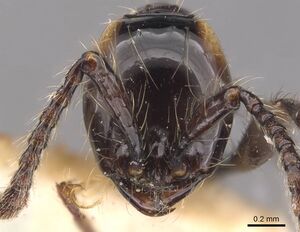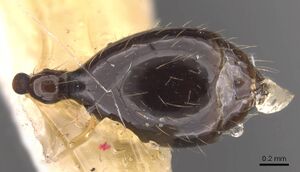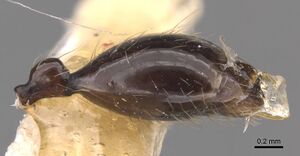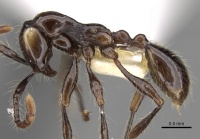Aenictus huonicus
| Aenictus huonicus | |
|---|---|

| |
| Scientific classification | |
| Kingdom: | Animalia |
| Phylum: | Arthropoda |
| Class: | Insecta |
| Order: | Hymenoptera |
| Family: | Formicidae |
| Subfamily: | Dorylinae |
| Genus: | Aenictus |
| Species: | A. huonicus |
| Binomial name | |
| Aenictus huonicus Wilson, 1964 | |
Workers were discovered on a bright sunny morning, running in file over a log at the edge of a native trail in open secondary rainforest in In Wamuki, New Guinea (Wilson 1964).
Identification
Jaitrong and Yamane (2011) - A member of the currax group.A. huonicus is very similar in general appearance to Aenictus currax, Aenictus diclops, Aenictus pfeifferi, Aenictus parahuonicus, and Aenictus wayani. Among them this species is closely related to A. pfeifferi and A. parahuonicus more than the others, the former two sharing a shorter antennal scape with SI 75–94 (more than 96 in A. currax, A. diclops, and A. wayani). However A. huonicus is easily separated from A. pfeifferi by the head having some shorter standing hairs in addition to two long hairs on vertex (only 2 long standing hairs present on vertex in A. pfeifferi) and the longest pronotal hair (0.35–0.40 mm) being longer than in A. pfeifferi (0.23–0.25 mm). A. huonicus differs from A. parahuonicus in having the declivity of the propodeum encircled with a thin rim (declivity not encircled with a rim in the latter).
Keys including this Species
Distribution
Latitudinal Distribution Pattern
Latitudinal Range: -3.089444444° to -8.766670227°.
| North Temperate |
North Subtropical |
Tropical | South Subtropical |
South Temperate |
- Source: AntMaps
Distribution based on Regional Taxon Lists
Indo-Australian Region: New Guinea.
Distribution based on AntMaps
Distribution based on AntWeb specimens
Check data from AntWeb
Countries Occupied
| Number of countries occupied by this species based on AntWiki Regional Taxon Lists. In general, fewer countries occupied indicates a narrower range, while more countries indicates a more widespread species. |

|
Estimated Abundance
| Relative abundance based on number of AntMaps records per species (this species within the purple bar). Fewer records (to the left) indicates a less abundant/encountered species while more records (to the right) indicates more abundant/encountered species. |

|
Biology
==Castes==
Known only from the worker caste.
Images from AntWeb
     
| |
| Paratype of Aenictus huonicus. Worker. Specimen code casent0905731. Photographer Will Ericson, uploaded by California Academy of Sciences. | Owned by MSNG, Genoa, Italy. |
Nomenclature
The following information is derived from Barry Bolton's Online Catalogue of the Ants of the World.
- huonicus. Aenictus huonicus Wilson, 1964a: 465, figs. 24, 25 (w.) NEW GUINEA (Papua New Guinea).
- Type-material: holotype worker, 7 paratype workers.
- Type-locality: holotype Papua New Guinea: Huon Peninsula, Mongi-Mape Watershed, Wamuki, 800 m., 19-20.iv.1955, no.859 (E.O. Wilson); paratypes with same data.
- Type-depository: MCZC.
- Status as species: Bolton, 1995b: 59; Jaitrong & Yamane, 2011: 18 (redescription).
- Distribution: Papua New Guinea.
Unless otherwise noted the text for the remainder of this section is reported from the publication that includes the original description.
Description
Jaitrong and Yamane (2011) - Measurements. holotype and paratypes (n = 4): TL 4.20–4.25 mm; HL 0.90–0.95 mm; HW 0.75–0.80 mm; SL 0.70–0.73 mm; ML 1.38–1.53 mm; PL 0.35–0.38 mm; CI 81–86; SI 87–94.
(holotype and paratypes). Head in full-face view clearly longer than broad, with sides slightly convex and posterior margin almost straight or feebly concave; occipital margin bearing a narrow collar. Antennal scape extending 2/3 of head length; antennal segments II–VI each longer than broad and of approximately same length; VII–IX thicker and slightly longer; X longer than VIII+IX. Frontal carina short, not extending beyond the level of posterior margin of torulus. Parafrontal ridge essentially absent. Masticatory margin of mandible with a large apical tooth followed by a medium-sized subapical tooth and 6–7 denticles. Mesosoma slender; promesonotum in profile convex dorsally and sloping gradually to metanotal groove; mesopleuron clearly demarcated from metapleuron by a groove. Propodeum in profile with convex dorsal outline; propodeal junction marked by a distinct carina; declivity of propodeum short, shallowly concave, and encircled with a thin rim; metapleural gland bulla large, raised; distance between propodeal spiracle and the bulla less than spiracular diameter; opening of the spiracle clearly circular, about 2.7 times as long as diameter of postpetiolar spiracle. Petiole slightly longer than high, with its dorsal outline convex; subpetiolar process low, with its anteroventral corner angular and ventral margin almost straight or feebly convex. Postpetiole slightly shorter than petiole and almost as long as high, with its dorsal outline convex.
Head including mandible and antennal scape entirely smooth and shiny. Pronotum smooth and shiny except for the anteriormost portion punctate; mesonotum smooth and shiny; mesopleuron sculptured, anepisternum wrinkled while katepisternum macroreticulate; mesopleuron with several irregular longitudinal ridges; matpleural gland bulla almost smooth; propodeal dorsum smooth and shiny; lateral face of propodeum with several irregular longitudinal ridges, but shiny. Petiole smooth and shiny dorsally, its anterior and posterior portion punctate, lateral face microreticulate or shagreened with smooth and shiny bottoms. Postpetiole entirely smooth and shiny. Legs entirely smooth and shiny.
Head with some shorter standing hairs in addition to two long hairs on vertex; mesosoma with relatively sparse standing hairs mixed with sparse short hairs over the surface; longest pronotal hair 0.35–0.40 mm long. Entire body dark reddish-brown, with a relatively small typhlatta spot on each occipital corner.
Type Material
- Holotype, worker, Wamuki, Mongi-Mape Watershed, Huon Peninsula, 800m, Papua New Guinea, 19–20 April 1955, E.O. Wilson, Museum of Comparative Zoology.
- Paratype, 3 workers, Wamuki, Mongi-Mape Watershed, Huon Peninsula, 800m, Papua New Guinea, 19–20 April 1955, E.O. Wilson, Museum of Comparative Zoology.
Jaitrong and Yamane (2011) - Holotype and three paratype workers from New Guinea, Huon Peninsula, Mongi-Mape Watershed, Wamuki, 800 m alt., 19–20 IV 1955. E. O. Wilson leg. (Museum of Comparative Zoology, examined).
References
- Khachonpisitsak, S., Yamane, S., Sriwichai, P., Jaitrong, W. 2020. An updated checklist of the ants of Thailand (Hymenoptera, Formicidae). ZooKeys 998, 1–182 (doi:10.3897/zookeys.998.54902).
- Jaitrong, W. & Yamane, S. 2011. Synopsis of Aenictus species groups and revision of the A. currax and A. laeviceps groups in the eastern Oriental, Indo-Australian, and Australasian regions (Hymenoptera: Formicidae: Aenictinae). Zootaxa, 3128, 1–46. PDF
- Wilson, E. O. 1964a. The true army ants of the Indo-Australian area (Hymenoptera: Formicidae: Dorylinae). Pacific Insects. 6: 427-483 (page 465, figs. 24, 25 worker described)
References based on Global Ant Biodiversity Informatics
- Borowiec M. L. 2016. Generic revision of the ant subfamily Dorylinae (Hymenoptera, Formicidae). ZooKeys 608: 1–280.
- CSIRO Collection
- Janda M., G. D. Alpert, M. L. Borowiec, E. P. Economo, P. Klimes, E. Sarnat, and S. O. Shattuck. 2011. Cheklist of ants described and recorded from New Guinea and associated islands. Available on http://www.newguineants.org/. Accessed on 24th Feb. 2011.
- Lucky A., E. Sarnat, and L. Alonso. 2011. Ants of the Muller Range, Papua New Guinea, Chapter 10. In Richards, S. J. and Gamui, B. G. (editors). 2013. Rapid Biological Assessments of the Nakanai Mountains and the upper Strickland Basin: surveying the biodiversity of Papua New Guineas sublime karst environments. RAP Bulletin of Biological Assessment 60. Conservation International. Arlington, VA.
- Snelling R. R. 1998. Insect Part 1: The social Hymenoptera. In Mack A. L. (Ed.) A Biological Assessment of the Lakekamu Basin, Papua New Guinea, RAP 9. 189 ppages
- Snelling R. R. 2000. Ants of the Wapoga river area, Irian Jaya, Indonesia. In Mack, Andrew L. and Leeanne E. Alonso (eds.). 2000. A Biological Assessment of the Wapoga River Area of Northwestern Irian Jaya, Indonesia. RAP Bulletin of Biological Assessment 14, Conservation International, Washington, DC.
- Wilson E. O. 1964. The true army ants of the Indo-Australian area (Hymenoptera: Formicidae: Dorylinae). Pacific Insects 6: 427-483.
- Wilson E. O. 1965. A consistency test for phylogenies based on contemporaneous species. Systematic Zoology 14: 214-220.


